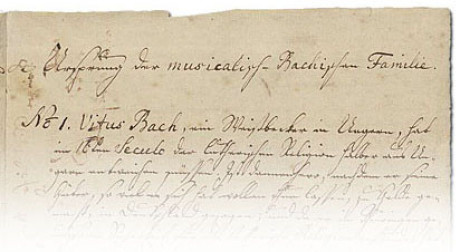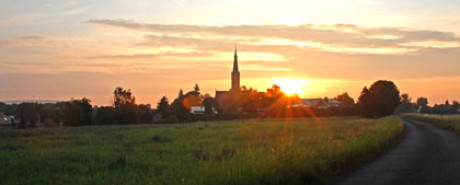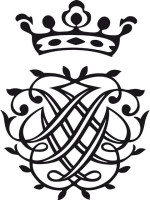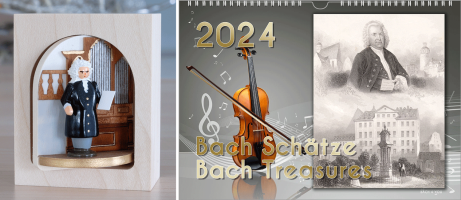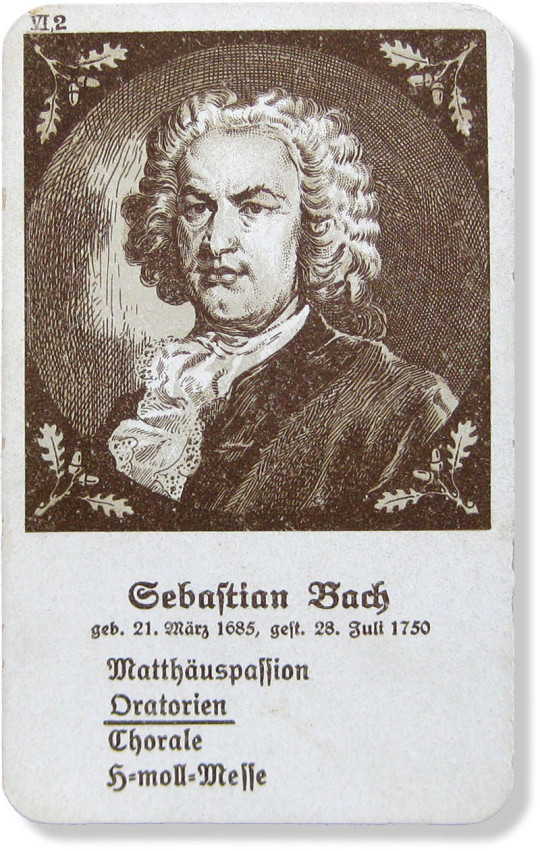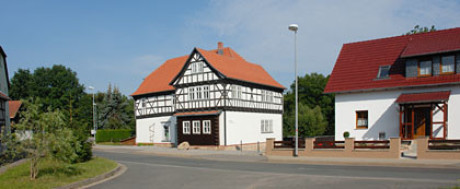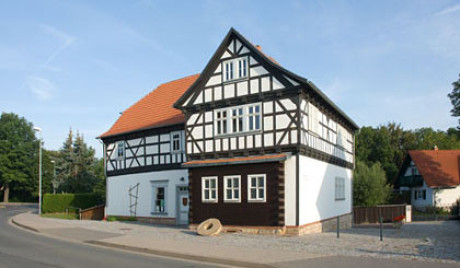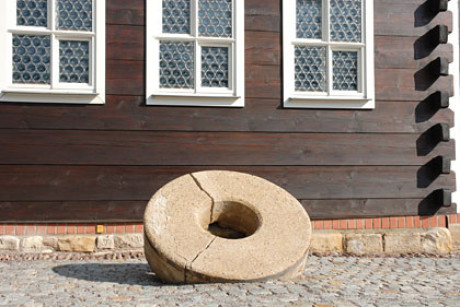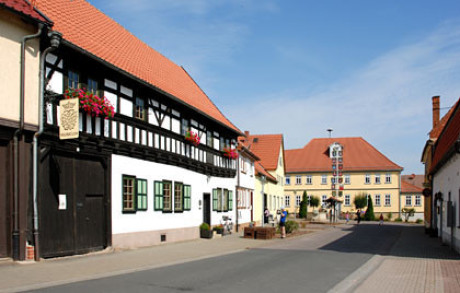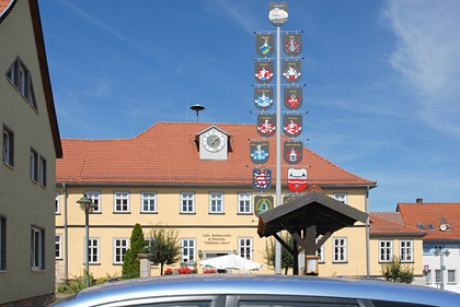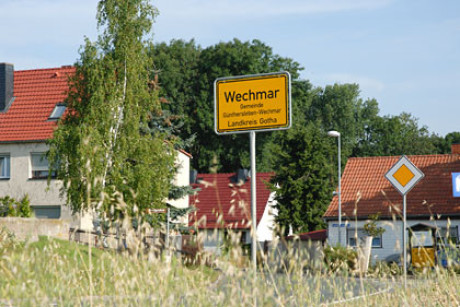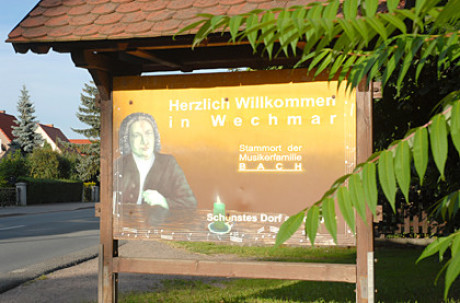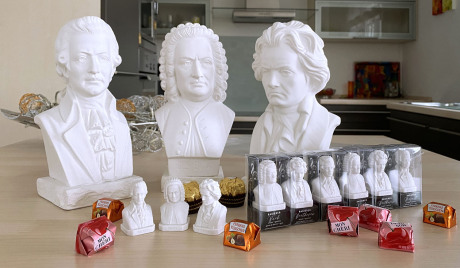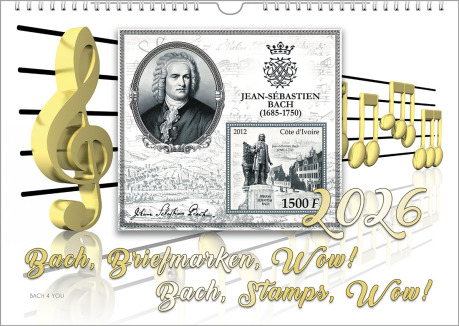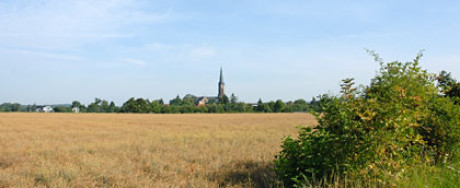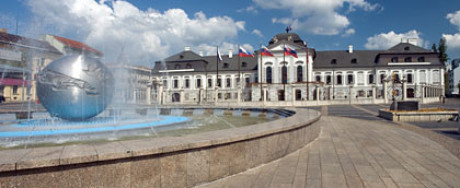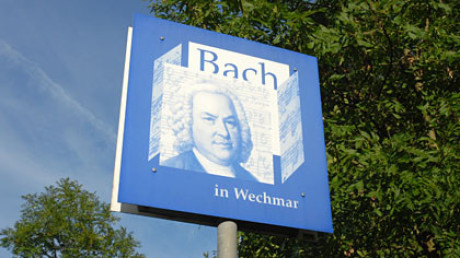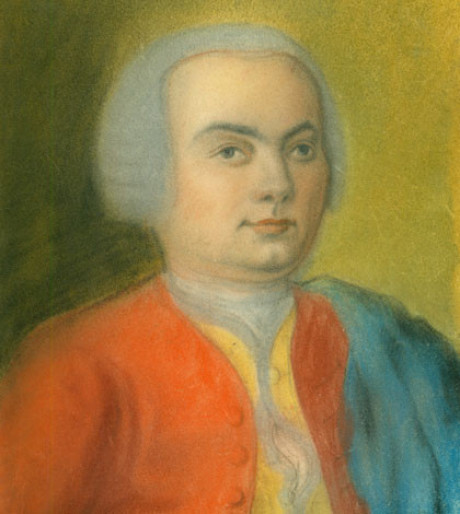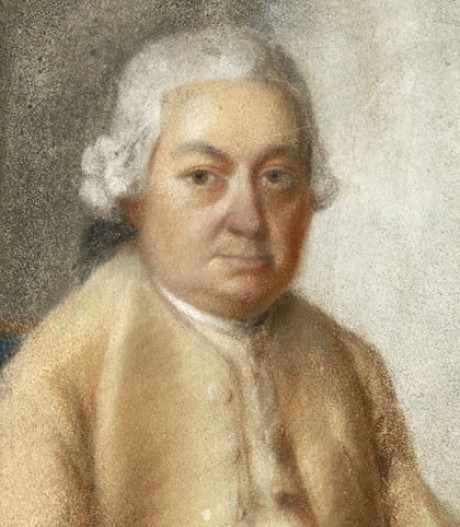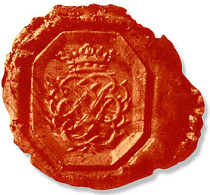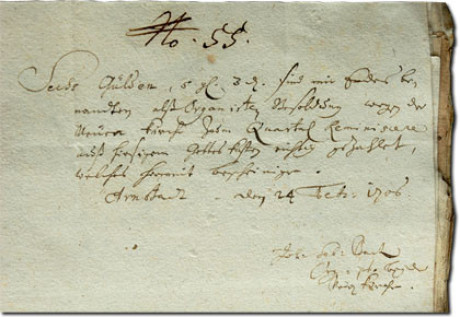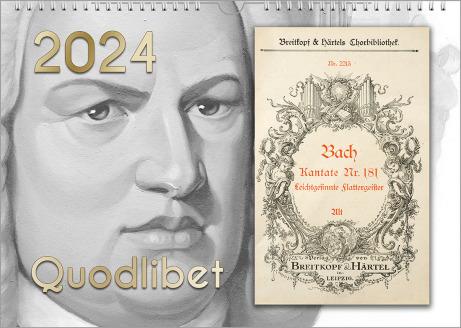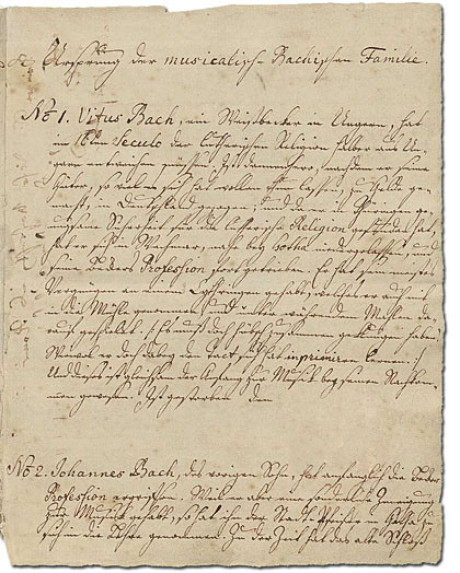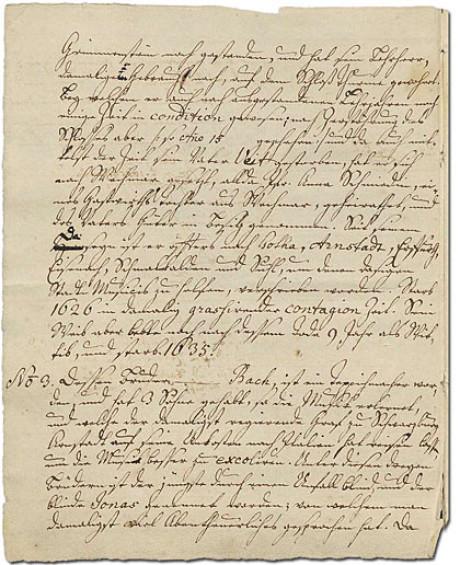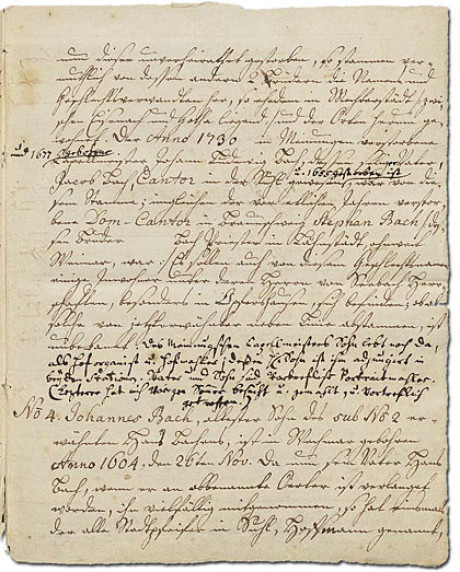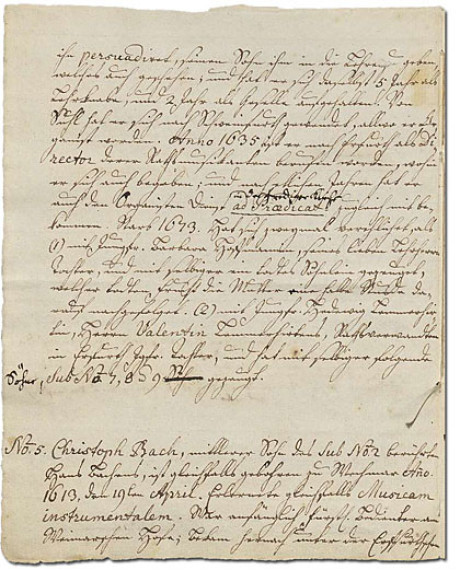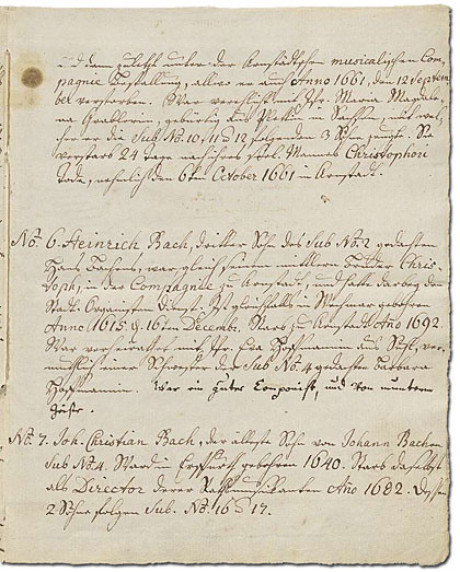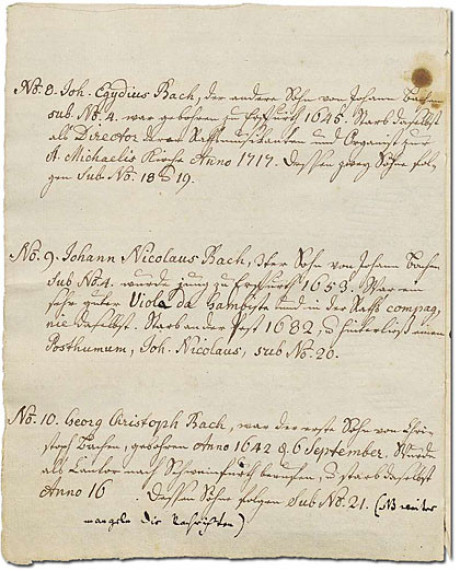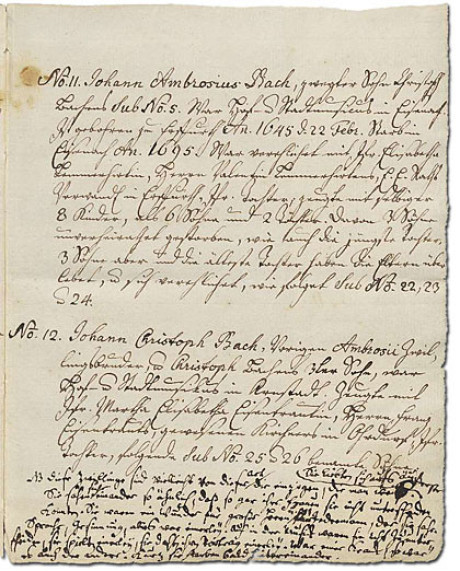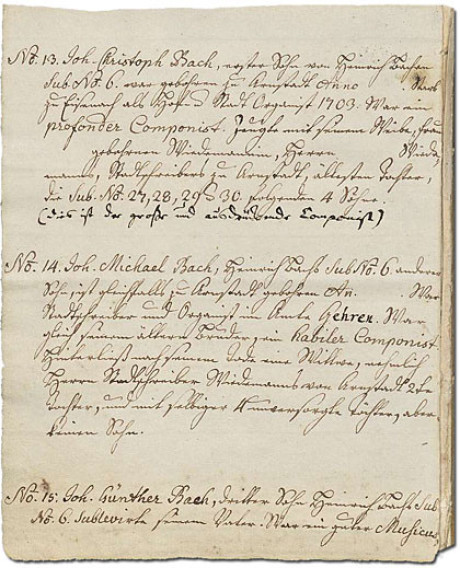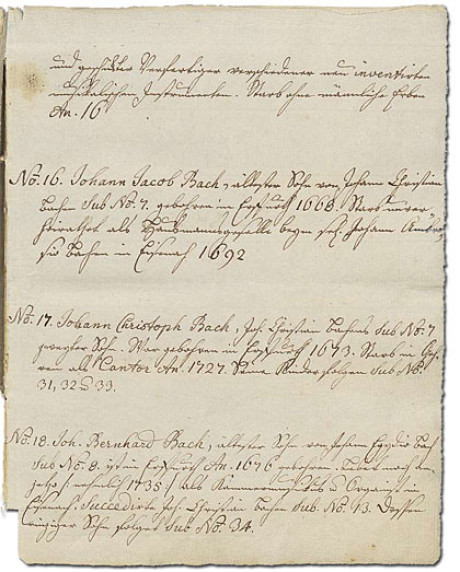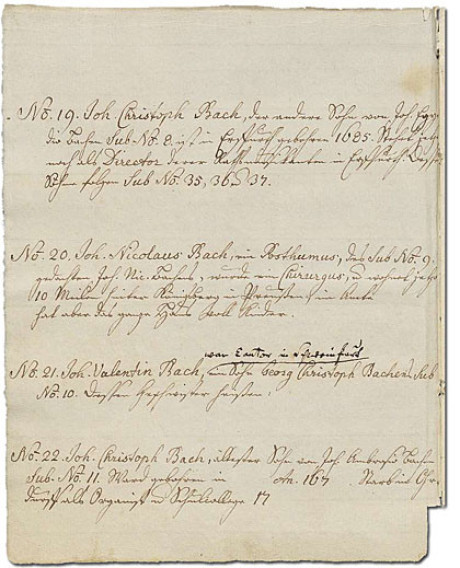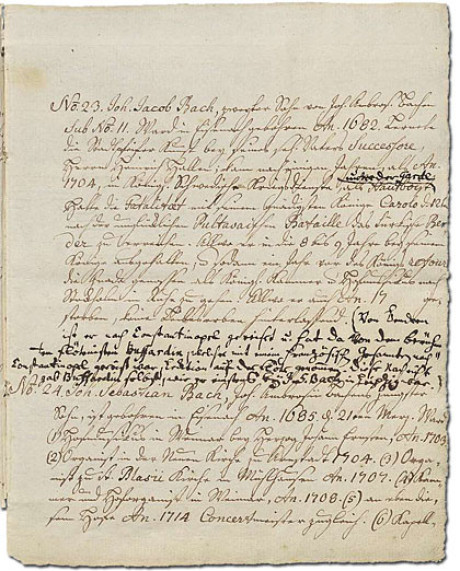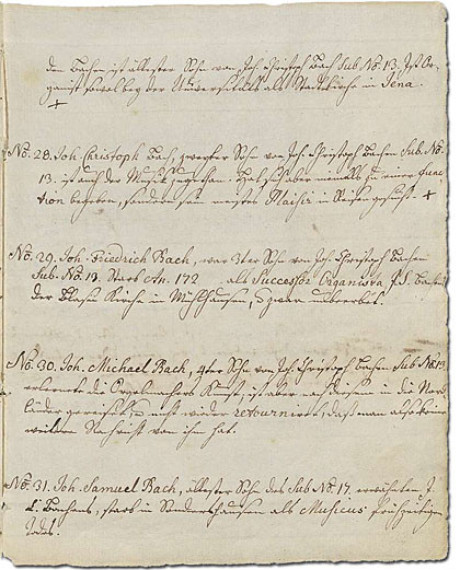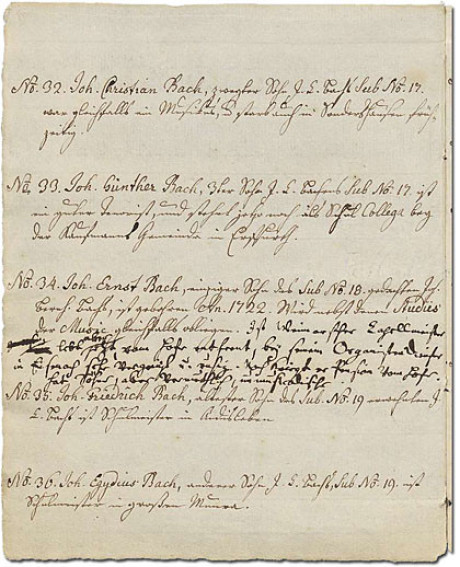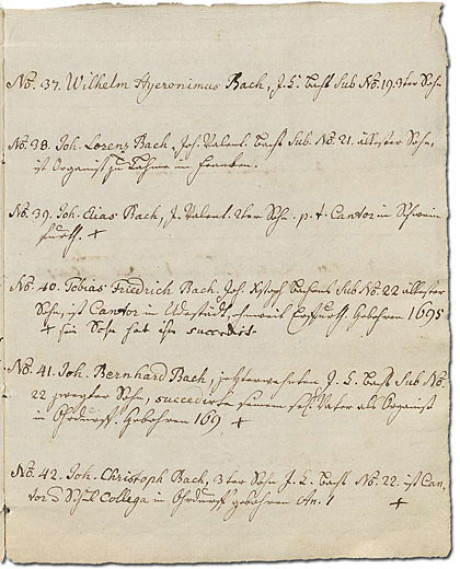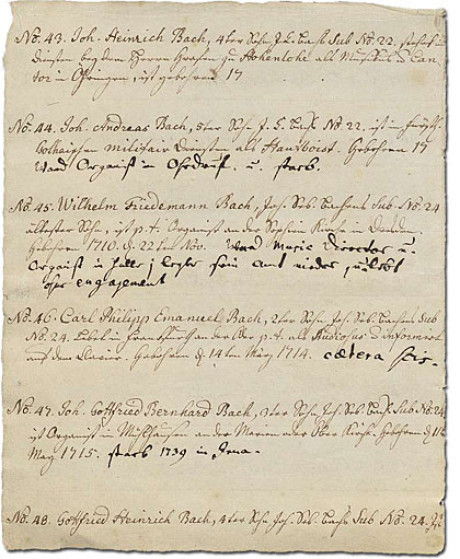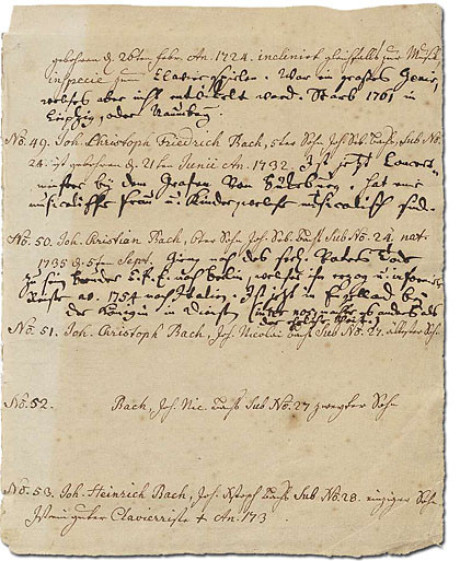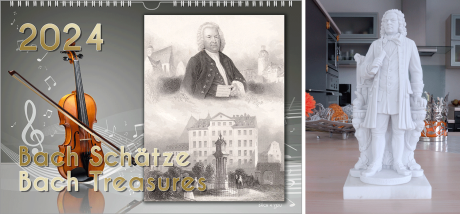The Ursprung ("The Beginning") 1735 by Johann Sebastian Bach
A document of priceless value: The "Genesis of the Musical Bach Family" (Ursprung der musicalisch-Bachischen Familie) in handwriting. It is collected by the master Johann Sebastian Bach himself, but this is not his handwriting. From here please be reminded: genesis in German is "Ursprung" and to keep it as authentic as possible I might not translate it everywhere you discover it.
Shortcut to both the original and the translation of
the "Ursprung" / "Genesis" of Johann Sebastian Bach.
"Genesis of the Musical-Bach Family" by Johann Sebastian Bach ("Ursprung der musicalisch-Bachischen Familie")
Dawn in the history of the "Bach Family of Musicians" brings Bach fans to the community of Wechmar, Thuringia, Germany. Wechmar is located next door of the Bach city of Gotha. Like in the photo above once Veit Bach might have seen the church tower of the Saint Viti Church from far, when he came to Wechmar in the year 1600, 15 years more or less. Maybe from Hungary, maybe it was an early morning, maybe he came back ( ! ): after many decades, back home or back to the homeland of his parents. On the one hand: who knows such a thing exactly? On the other hand: you could examine such more precisely - where actually is the Ursprung of the musicalisch-Bachische Familie, the genesis of the musical-Bach family.
Did you know, Johann Sebastian Bach created his own family seal? And surely you recognized the six letters in the lower part of the seal? There is a whole story about the Bach Family Seal and so actually there are two of those seals, an old one and a new one. However, ... this is just another chapter, which will come into being very soon.
Advertisement
99 Music Calendars, Composers Calendars and Bach Calendars
Bach calendars are music calendars as well. 3 sizes. 2024 + 2025. US style + EU style. To the shop. By the way: On the left it is the "Bach Turning Box", the "Bach Drehkastl".
You know it meanwhile, because the Ursprung – the Genesis – is surely not the first page, that you read on "Bach on Bach": with a quick click - and that is exactly here - you are at the start of the original pages of the "Ursprung der musicalisch-Bachischen Familie", the genesis of the musical-Bach family with no delay at all. In handwriting. And with another click – here and now as well – you get directly to this genesis in nowadays font without any detours. A font, like the one you currently read here. If you actually want to read more than the pure "Ursprung", excuse me the "Ursprung der musicalisch-Bachischen Familie", the "Genesis of the Bach Family of Musicians", that is all the stuff around, than you are invited to explore the next paragraphs first.
And why is that so? What is different? With "Bach On Bach" you do not just get to see the original. Plus in addition nowadays convenient to experience font. Because I highlight a document of priceless value for you as well from different angles. That is one, which is of great importance for the Bach science. Plus the angle, that is so important for the Bach genealogy and mirrors in every expertise. In addition, there is more exciting stuff to discover. And like always on "Bach On Bach" there are pictures and illustrations – just fun, entertainment and knowledge.
These were the good old times when children used to play cards. You could play cards with almost any theme. Today those playing cards became priceless treasures for collectors and this Bach card for me is a jewel. Priceless? Okay, we don't want to overdo it.
Wechmar, Thuringia – Bach Meets Music
The "Veit Bach Muehle", the Veit Bach Mill in the community of Wechmar. That is like you can explore the mill today. To the right and behind: private residences. The bow around the mill: the currently new built road. Wechmar lies in Thuringia. Here the story of the most famous family of musicians of all times started. Nowhere else. Not in Hungary, not in Pressburg, not in Papua New Guinea. The Veit Bach Mill survived by a hair. Thanks to the alertness of the Bach fans at Wechmar.
The Veit Bach Mill, which wasn't torn down by the hair. You clearly see the street making a bow around the building. Projected ... wasn't that path not at all.
The picture comes with the "Ursprung der musicalisch-Bachischen Familie". What would a mill be without a millstone? Did you get the German, by the way?
The same name is an indication, where Veit came from. Veit Bach – the Saint-Viti-Church in Wechmar. Is it an accident?
For Bach fans from the whole world, there is no way around Wechmar: the Bach Stem House (das "Bach-Stammhaus") invites you – and just three houses to the right, the café, restaurant plus bed and breakfast "Golden Lion", the "Goldene Löwe".
Lion, closer. Lodge there, eat there: my personal recommendation. It's a real Bach place, ask the innkeeper why that is so.
Here it started, here is the genesis, the "Ursprung der musicalisch-Bachischen Familie": in Wechmar, in Thuringia, in Germany.
Bach "Ursprung", which is Bach genesis plus prettiest village – in Wechmar both is possible. And they are proud of this fact.
Advertisement
99 Music Calendars: Organ Calendars, Composers Calendars, Bach Calendars, and Many Bach Gifts and Music Gifts More
Please support our Bach mission … learn more.
Bach calendars are music calendars as well. 3 sizes. 2024 + 2025. US and EU style. To the shop.
End of Advertisement
More Pics? More Text?
You don't want any pictures anymore and no entertaining comment at all. You want to read the "Ursprung der musicalisch-Bachischen Familie", excuse me the "Genesis of the Musical-Bach Family" now? Well, then please click here.
There are three assumptions, where exactly the "Ursprung of the musicalisch-Bachischen Familie" is to find. That is first and foremost Wechmar in Thuringia, Germany ...
... secondly, it's Bratislava, Slovakia. Bratislava's former name was Pressburg. It was part of Austria and part of Hungary and for a while, it was part of Austria-Hungary. Actually, nothing points to this dreamlike city as the genesis of Veit Bach ...
... and finally, it's Papua New Guinea. Bach scientists might be surprised and many Bach admirers might hear about such for the first time: Papua New Guinea as the origin of the Bach family. In the United States of America and among a small group of Bach genealogists folks have very different opinions. What it's all about – and why it could only be theoretically – you may read on this website – but not yet here.
Wechmar ( ! ) is the origin, the "Ursprung der musicalisch-Bachischen Familie", which is the genesis of the musical-Bach family. There is nothing to be said against it. Proof for the opposite is missing completely. And indications, which point to Wechmar even a long time before the time of Veit Bach, are impressing. At the end of that little presentation of photos related to the "Ursprung der musicalisch Bachischen Familie" (...you know the English for that meanwhile): here in Wechmar some 400 years ago a 500-year-long family tradition started. Are you confused a little? That is okay. On this page of my website, you will find no answer on that, but you will find an answer on the Bach genealogy pages. But one thing is true: Bach is just not that easy – in almost no discipline.
What exactly is the "Ursprung der musicalisch-Bachischen Familie"?
What exactly is the Ursprung, that is the genesis of the musical-Bach family? The answer: this Ursprung is a list of 53 members of the Bach family of musicians, which Johann Sebastian Bach has collected and written himself, when he was 50 years old. First impressive fact is actually, that Johann Sebastian Bach put that list together, when he was 50 ( ! ). Because the age of 50 – more or less – still today is the age, when many folks get started be interested in genealogy. At least that is, what researchers say, who are doing a lot of research already for a while. But this detail is important as well, because all that Johann Sebastian wrote down, is only what happened until 1735 – genealogy-wise. Secondly it is of importance, that Johann Sebastian Bach didn't know all the information 1735, which we know today because of better research options. And you do recognize perfectly that genealogy was not one of Bach's favorite passions. If he had hobbies at all. At least nothing is handed down.
The 53 Gentlemen in the "Ursprung"
One of the gentlemen in the "Ursprung", how we almost don't know him today and like you will find him in the next picture: Carl Philipp Emanuel Bach, one of the four famous Bach Sons. Additional comments in the original "Ursprung" are written by him between the handwriting before. You recognize these comments coming with the darker, little bolder writing.
53 members of a really musical family of musicians. You want it more precise? The Ursprung is about 53 gentlemen in the most well-known and largest family of musicians all over the world. Der Ursprung is the Genesis is an acronym for the even for Germans hard to keep in mind term of Ursprung der musicalisch-Bachischen Familie, which is the genesis of the musical-Bach Family. The most well-known family of musicians all over the world and of all times as well. How do you measure such a thing? Two approaches. First the number of musicians is what counts, secondly the grade of publicity. Thirdly you can argue about the facts one and two or at least be an issue. After all there are only few families of musicians, who play in that league of the famous families of musicians. Wagner was the distinguished master in such a family of musicians. But that almost ends the list. Because either we have to leave the league of the best of the best or we have to agree that already three generations – okay, or two – make them a family of musicians. Who else is there? Strauss, you know it: Strauss Father, Strauss Son. Plus very few more.
Aside from Johann Sebastian Bach, his four sons play a big role in this "discipline", better his four famous sons. At the time they were living, they even were more famous than their father. Today they are not to be found on the front places in a world ranking list. However: now the third and fourth league of the Bache, which was the plural of Bach back then. And on that level, there have been countless, regional and local well-known musicians. And that is true for both, composing and performing music. Considering that there is a time period of some 500 years, those who made music is almost countless. These were musicians, composers and even producers of instruments and instrument dealers. Even today they live in different countries and some of them are still making their living with performing music. Bottom line it's even a high percentage of family members, who act and live music oriented. The "Ursprung": actually a list of 53 family members of the biggest and most well-known family of musicians all over the world. By the way, not all 53 were musicians, but almost.
That is how we recognize him: Carl Philipp Emanuel Bach, No. 45 in the "Ursprung der musicalisch-Bachischen Familie."
Is the Ursprung a pedigree? A clear "No". A crystal clear "No". From the sight of the Bach science, it is one. From the sight of those who are interested in Johann Sebastian Bach as well. From the view of genealogist ... it is no pedigree. Not at all. Without a doubt, it's the basis for one. No doubt, the "Ursprung" is of exceptional value. It is surely a sensation and it's a dream, to have it as a source to learn from. However: was the "Ursprung der musicalisch-Bachischen Familie" meant to be a pedigree? "No" – again. What actually is it after all – and how do I have the impertinence of that statement? As all sources, which you possibly can check, tell the opposite? First, there is a simple answer to the question, what actually than is the Ursprung? It is a list of 53 persons of the family of Johann Sebastian Bach, who was male and as well (... almost all of them) made music.
The seal of Johann Sebastian Bach on sealing wax. As a graphic presentation it's more popular, on sealing wax it is rare.
More complex is the justification, why the Ursprung der musicalisch-Bachischen Familie is no family tree. And what Johann Sebastian Bach wanted to document, when he put together the list at Leipzig, at the age of 50 in the year 1735. In his personal handwriting. Exactly – that is what I assume – Bach wanted to list those family members, whom he knew as musicians without doing too much research. He had no genealogy ambitions at all. None. And coming to No. 20 and to No. 21 you may as well ask yourself, why of all people these persons are listed in the Ursprung – and others are not. Because it the Ursprung would list just the musicians in the family, than No. 28 and No. 35 would definitely not belong into that list. And that is without a big background check, because Johann Sebastian Bach himself said so, that both persons had nothing to do with music at all.
It's enough. Now you want to the "Ursprung"? Click here and you will get to the original (...caution, it's not only in German but in handwriting plus old-style German) – or you get here to the German nowadays font. Or you click here and you will be able to read it easily as this is the link to the English translation.
Let's go on: in this list, in the "Ursprung", not only all ladies and girls are missing, but most of Bach's children are not listed as well. Beyond that, everyone who does ancestry makes one experience in the very first hours of his or her new passion: you write down all dates of birth, you write down all dates of death and you write down all places of birth. And he or she experiences that time plays a big role. It plays a gigantic role, to get information from sources, which might not be accessible one day later. It's that easy because grandma might get ill or grandma might just die. Everybody – really everybody – who starts genealogy as a beginner realizes, how easy it would have been, to ask his grandfather 10, 20 or 30 years earlier about the name of his grandfather, where he came from and what the names of his brothers and sisters were. There is really nobody who – with the beginning of this new hobby – hasn't regret to have asked the deceased generation more. And what is the result? The awareness who important the conservation of easy to get data for the coming generations is: better today than tomorrow! Now let's have a look at the Ursprung der musicalisch-Bachischen Familie. We realize the following: the closer a birth approaches the era of the Thomas Cantor, the more careless this data is collected. Make the experience yourself (... here is a quick link to one example and there is a link back to this line). That is why I state it in plain English: the closer to 1735 a member of the family was born, the easier the master would have become aware of these birth dates, both day and location. Just a call would have done it. Or an e-mail.
This ( ! ) is the handwriting of Johann Sebastian Bach. The handwriting in the "Ursprung" is not his.
Of course not. No further explanation. But it would have been as easy as 1-2-3, in the occasion of these family gatherings, which seemed to happen on a yearly base, to complete the missing data. Because even if the mentioned children or persons haven't been present in person – so many family members around one or the other would have had more information. When Johann Sebastian Bach put that Ursprung together, the next family gathering was a maximum of twelve months ahead. But he hasn't completed the data. Many are missing. So – it wasn't important to him. And if it wasn't important, there is proof it was no genealogy.
What actually is considerable in the "Ursprung", more precise in "the Ursprung der musicalisch-Bachischen Familie, in English the "Genesis of the musical-Bach Family", which Johann Sebastian Bach personally put together in the year 1735? More precisely: it is about the No. 1 in the list, the ancestor of the family of musicians. Whether we regard it genealogically or not. What is absolute to the point is, what Johann Sebastian Bach listed there as the No. 1 on the list? On a genealogical base, it's either a) an allegation, b) an indication or c) a proof for the existence and the correctness for the existence of this family member. It's crystal clear, it's no proof. As an official document or something document like as a church record would be to proof the truth is missing. And Johann Sebastian Bach does not state his knowledge and mentions a church document or a document of another nature. We assume, and it's nowhere mentioned in the Bach sciences or bibliographic literature, that it's a transmission from one generation to the next. Even if this seems to be obvious. In a time when you called it a day, when the light was almost not good enough to read anymore and when there was almost nothing to read at all, in the sense of magazines and exciting books. You just talked more and you told stories about generations before, stories which were carried through generations and history.
What Johann Sebastian Bach wrote down in his "Ursprung", is in all likelihood history that was told by the generations before. Grandfathers reported stories of their grandfathers. It's history, handed down history. Be honest, do you know where your great-grandfather was born? Genealogy researchers are excluded now from guessing and speculating. Back to the "Ursprung".
It's not handed down, whether Johann Sebastian Bach was able to build his "Ursprung" by checking data in church records. However, it's absolutely unlikely, he did such, because as said before, if he had tried to get information out of church records, he would have put more effort to get way easier to research data and write it down in his consideration and list. Nowhere is mentioned, where Bach researched his knowledge. The probability, that this information was handed down generation by generation, is just the most likely option. If related to the statement for No. 1 the rank of a proof bowed out, claim (hypothesis) and indication remain. That it's just an argument, that Veit Bach came from Hungary, is extremely unlikely. A "construction", that is just to come up with such a thing, would be very strange. Now, if it's neither just a claim, but on the other hand we are missing the proof for the correctness regarding the content related to the text coming with the No. 1, then we have to consider the statement regarding Veit Bach and his existence as an indication. Why this is so important, is what you will learn at a very different place on this website. Why actually this complicated explanation is of importance, plays a role, is because we didn't put this paragraph here in this section of the website, not on the Bach genealogy pages. Is it bean counting? If you are interested in the Bach Genealogy around Johann Sebastian Bach, it's indeed. But if you are interested in this particular Bach Genealogy – it's actually not.
Advertisement
T-Shirts, Hoodies, Mugs and Steins ... all Related to the Subject of Music and Bach
Bach calendars are music calendars as well. 3 sizes. 2024 + 2025. US and EU style To the shop.
Discover thousands of music gifts here. To the shop.
End of Advertisement
What actually is the "Ursprung" ... and what is it precisely?
The "Ursprung" is a list of 53 family members of the Bach Family of Musicians on nine pages, put together by Johann Sebastian Bach in person. The complete German title "Ursprung der musicalisch-Bachischen Familie", in English "Origin of the Bach Family of Musicians" and this document excited once in the handwriting of Johann Sebastian Bach. However today - this original is lost. But what is it, what you might already have seen on these pages of the Bach website, which is located a little down this page? and I tell you, it's not the handwriting of Joann Sebastian Bach. Whose handwriting then is it? It's the handwriting of Johann Sebastian Bach's granddaughter Anna Carolina Philippina Bach. And the littler darker and bolder writing between the lines is the handwriting of Bach's son Carl Philipp Emanuel Bach. Bach's granddaughter copied this nowadays original document, the "Ursprung". And Carl Philipp Emanuel Bach, the most famous of the four famous Bach sons wrote comments between the lines of his nice. This, exactly this, is handed down, has survived and you can experience it here. And read it as an original - an original , which is a copy of the original. Or, you enjoy this "Ursprung" from Johann Sebastian Bach in a more convenient way and readable version just a few pages later. There are three copies still existing and they are located in the "Staatsbibliothek zu Berlin im preußischen Kulturbesitz", which is in English the "Library of State in Berlin in Possession of the Prussia Culture Assets".
Finally Here It Is: The Ursprung of the Musical-Bach Family
Maybe, later it's going to get too painful, to read and to decode the "Ursprung" in the handwriting of Johann Sebastian Bach's granddaughter for you. However, you would love to know, what the whole pages are about, the "Ursprung". You just want it ready to be consumed, so to speak. Then you just click on the little buttons, which we placed all ten Ursprung numbers for you. And with pushing the button you land automatically at the transcription of number one, for instance, that is to say at Vitus Bach, the white baker – in a font, which is convenient to read for you. Plus Carl Philipp Emanuel didn't leave his comments between the lines.
Do you want to read this page of the "Ursprung" in nowadays English? Click here. From there you may get back to this very place after you read about the mentioned family members. You have one more option if you have fun reading some German: just around the corner, you will find a transcript in easy to read German. Click here.
For the "Ursprung der musicalisch-Bachischen Familie" in today's font, click here. For the Necrology in English, click here.
For the "Ursprung der musicalisch-Bachischen Familie" in today's font, click here. For the Necrology in English, click here.
For the "Ursprung der musicalisch-Bachischen Familie" in today's font, click here. For the Necrology in English, click here.
For the "Ursprung der musicalisch-Bachischen Familie" in today's font, click here. For the Necrology in English, click here.
For the "Ursprung der musicalisch-Bachischen Familie" in today's font, click here. For the Necrology in English, click here.
For the "Ursprung der musicalisch-Bachischen Familie" in today's font, click here. For the Necrology in English, click here.
For the "Ursprung der musicalisch-Bachischen Familie" in today's font, click here. For the Necrology in English, click here.
For the "Ursprung der musicalisch-Bachischen Familie" in today's font, click here. For the Necrology in English, click here.
For the "Ursprung der musicalisch-Bachischen Familie" in today's font, click here. For the Necrology in English, click here.
For the "Ursprung der musicalisch-Bachischen Familie" in today's font, click here. For the Necrology in English, click here.
For the "Ursprung der musicalisch-Bachischen Familie" in today's font, click here. For the Necrology in English, click here.
For the "Ursprung der musicalisch-Bachischen Familie" in today's font, click here. For the Necrology in English, click here.
For the "Ursprung der musicalisch-Bachischen Familie" in today's font, click here. For the Necrology in English, click here.
For the "Ursprung der musicalisch-Bachischen Familie" in today's font, click here. For the Necrology in English, click here.
For the "Ursprung der musicalisch-Bachischen Familie" in today's font, click here. For the necrology in English, click here.
Next Page Ursprung I Top
Back to the top, to the beginning of this page
"Ursprung der musicalisch-Bachischen Familie".
Next page of the "Ursprung",
chapter (Part/Page 2). Click here.
Advertisement
Music Calendars in Two Stiles and Thousands of Exciting Music Gifts
Music T-Shirts, music mugs, composer busts … learn more.
99 Music Calendars: Pipe Organ Calendars, Composers Calendars and Bach Calendars
Bach calendars are music calendars as well. 3 sizes. 2024 + 2025. EU + US style. To the shop.
End of Advertisement

